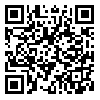دوره 5، شماره 4 - ( 7-1400 )
جلد 5 شماره 4 صفحات 275-267 |
برگشت به فهرست نسخه ها
چکیده: (1917 مشاهده)
Background: With the number of insurance customers growing, insurance companies are trying new ways to retain customers and streamline communication channels to avoid loss of revenue. The present study set out to develop a model for a reliable analysis of customer lifetime value.
Methods: The present study was exploratory mixed method in design. The study took place in Jundishapur University of Medical Sciences, located in Ahvaz, Iran. A total of 402 insurance experts and university staffers participated in the study. A cross-sectional data collection was done using semi-structured interviews (n = 22) and a questionnaire (n = 380). The latter was validated via a panel of content area experts, criterion-dependent validity (second-order confirmatory factor analysis), and divergent validity (cross-sectional load test and Fornell-Laker). Cronbach's alpha and combined reliability were - 0.8 and 0.8, respectively. A structural equation approach was employed to analyze data using Smart PLS software.
Results: Customer loyalty with an impact factor of 0.60 and T-statistic of 5.79, profitability with an impact factor of 0.55 and T-statistic of 3.75, customer co-creation with an impact factor of 0.28, and T-statistic of 2.7 have been identified as dimensions of customer lifetime value.
Conclusion: Measuring customer lifetime value to implement various strategies requires a deep understanding of such value dimensions as loyalty, profitability, and value creation.
Methods: The present study was exploratory mixed method in design. The study took place in Jundishapur University of Medical Sciences, located in Ahvaz, Iran. A total of 402 insurance experts and university staffers participated in the study. A cross-sectional data collection was done using semi-structured interviews (n = 22) and a questionnaire (n = 380). The latter was validated via a panel of content area experts, criterion-dependent validity (second-order confirmatory factor analysis), and divergent validity (cross-sectional load test and Fornell-Laker). Cronbach's alpha and combined reliability were - 0.8 and 0.8, respectively. A structural equation approach was employed to analyze data using Smart PLS software.
Results: Customer loyalty with an impact factor of 0.60 and T-statistic of 5.79, profitability with an impact factor of 0.55 and T-statistic of 3.75, customer co-creation with an impact factor of 0.28, and T-statistic of 2.7 have been identified as dimensions of customer lifetime value.
Conclusion: Measuring customer lifetime value to implement various strategies requires a deep understanding of such value dimensions as loyalty, profitability, and value creation.
نوع مطالعه: كاربردي |
دریافت: 1400/2/25 | پذیرش: 1400/7/30 | انتشار: 1400/7/30
دریافت: 1400/2/25 | پذیرش: 1400/7/30 | انتشار: 1400/7/30
| بازنشر اطلاعات | |
 |
این مقاله تحت شرایط Creative Commons Attribution-NonCommercial 4.0 International License قابل بازنشر است. |

